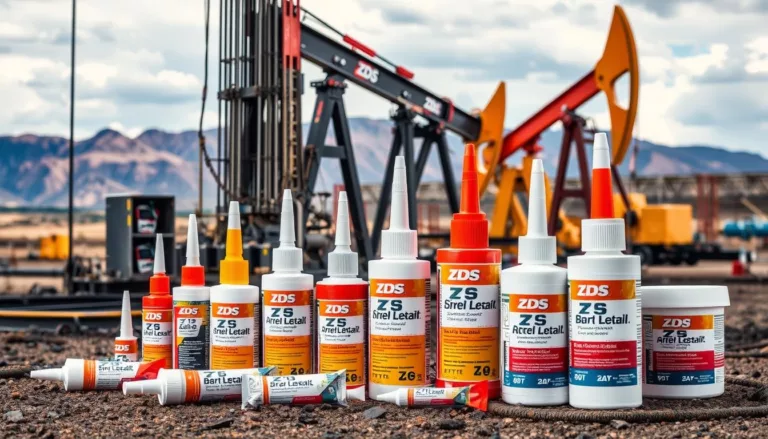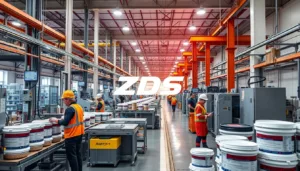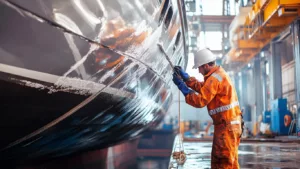The oil and gas industry faces tough conditions. This makes chemical-resistant adhesives in oilfields more important. These adhesives handle extreme temperatures, harsh chemicals, and a lot of stress. They ensure oilfield operations stay smooth.
Their advanced formulas allow for strong bonds on different materials. This keeps oilfield gear working well. These adhesives mean less maintenance and fewer repairs. This saves a lot of money for those in the industry.
Key Takeaways
- Chemical-resistant adhesives enhance operational reliability in challenging oilfield environments.
- Strong bonding capabilities help maintain the integrity of vital equipment.
- Advanced formulations minimize maintenance needs and repair costs.
- Durability in extreme conditions is a cornerstone of these adhesive products.
- Utilization of these adhesives promotes efficiency in oilfield operations.
- Reducing operational downtime is essential for maximizing productivity.
Overview of Chemical-Resistant Adhesives
Chemical-resistant adhesives are key in the oil industry. They are made to hold up against harsh chemicals and extreme conditions in oilfields. Knowing what they are, what they’re made of, and their types helps us understand their role and effectiveness in keeping operations going.
Definition and Composition
These adhesives are created to stand up to tough chemicals, high heat, and rough environments in oilfields. They’re made of polymers and special additives. These ingredients enhance their sticking power and make sure they work well, even when things get tough.
Types of Chemical-Resistant Adhesives
- Epoxy Adhesives: Known for their strong bonding capabilities and resistance to chemicals. Ideal for high-stress applications.
- Polyurethane Adhesives: Flexible and durable, making them suitable for varying temperatures and oilfield applications.
- Acrylic Adhesives: Excellent for bonding dissimilar substrates, offering good resistance to solvents and impacts.
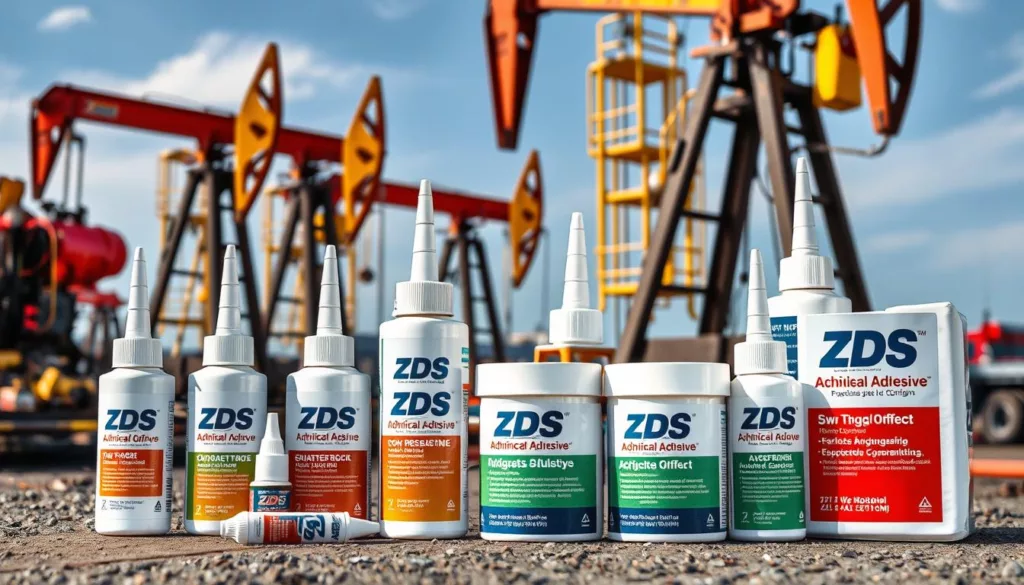
| Type | Benefits | Common Uses |
|---|---|---|
| Epoxy | High strength, excellent temperature resistance | Pipe fittings, structural bonding |
| Polyurethane | Flexibility, resistance to abrasion | Seals, gaskets |
| Acrylic | Fast curing, impact resistance | General bonding, repair projects |
Importance of Chemical-Resistant Adhesives in Oilfields
Chemical-resistant adhesives play a big role in oilfields beyond just sticking things together. They help operations run more smoothly and cut down on stoppages. This boosts overall work performance. Thanks to new adhesive technology, we’re seeing better and more reliable workspaces in oilfields.
Enhancing Operational Efficiency
Using chemical-resistant adhesives wisely can make oilfield operations more efficient. These adhesives stick well in many uses, making equipment more dependable. With better reliability, work gets done more smoothly. Fewer hold-ups mean operations keep going strong, keeping a competitive edge.
Reducing Downtime
Chemical-resistant adhesives are great at keeping downtime low in oilfields. Regular adhesives can’t handle the tough oilfield conditions. But chemical-resistant ones can take on extreme heat and chemicals. This means equipment works longer without needing fixes, keeping everything running well.
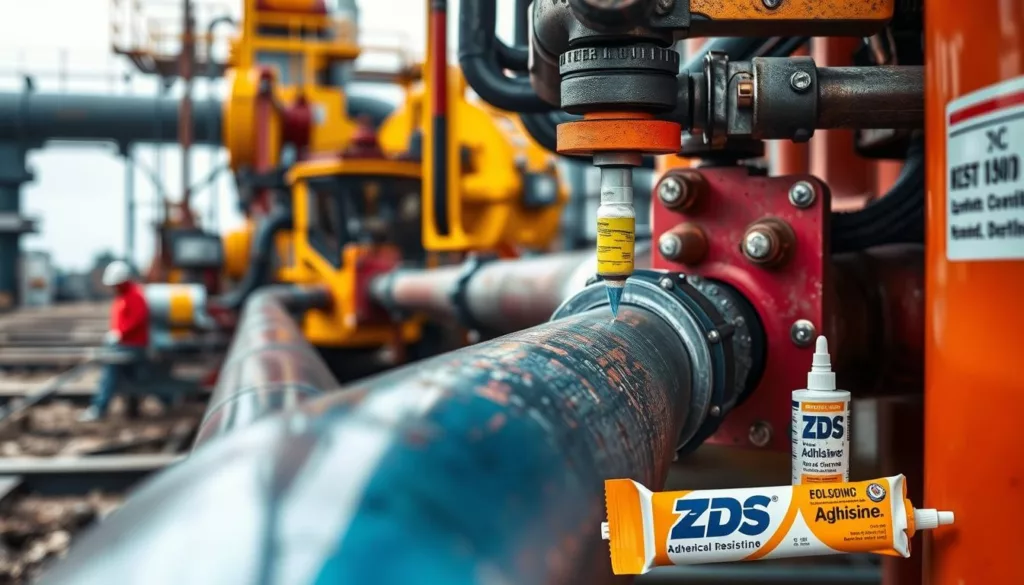
Key Benefits of Using Chemical-Resistant Adhesives
Choosing chemical-resistant adhesives is key to better operations in oilfields. These adhesives offer many benefits in tough conditions. They help leaders in the energy industry make smart choices for their gear.
Improved Durability
Chemical-resistant adhesives are very durable in oilfields. They don’t break down easily from chemicals, which means less replacement and repairs. Their strength is crucial to keep things running smoothly under stress.
Resistance to Harsh Environments
Oilfields often face harsh substances every day. Adhesives that resist corrosion work well here, keeping parts safe from harm. They stand up to rough chemicals, extreme heat, and dampness. This keeps equipment reliable, dodging costly breaks and unwanted stops.
Long-Term Cost Effectiveness
High-quality adhesives are a smart long-term investment in the energy field. Though they might cost more upfront, they save money on maintenance down the line. Companies find they get great value, with adhesives lasting a long time.
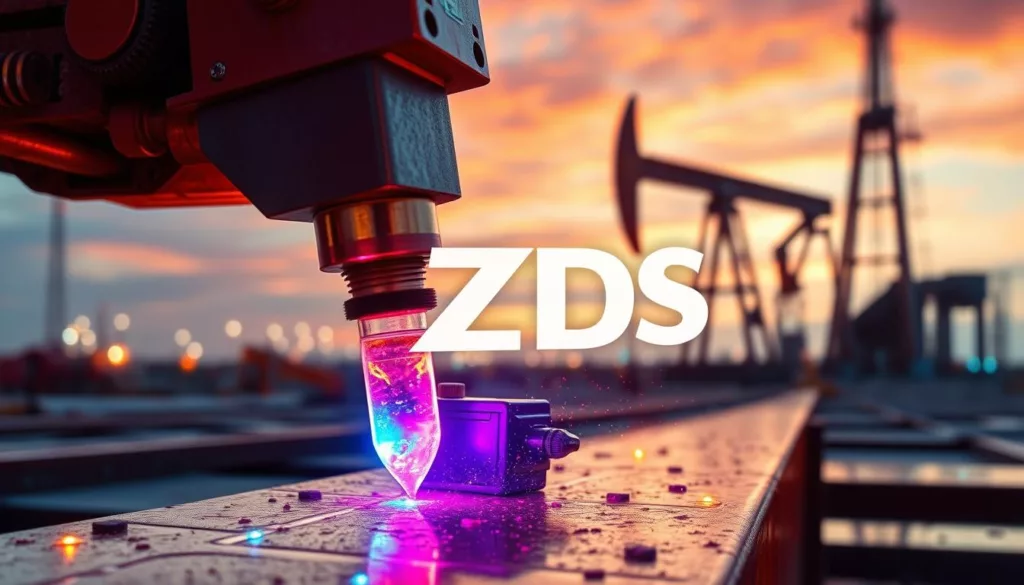
| Benefit | Description | Impact on Operations |
|---|---|---|
| Durability | Resists chemical degradation and wear | Reduces the need for frequent repairs |
| Harsh Environment Resistance | Protects against chemicals and extreme conditions | Avoids failures and unplanned downtimes |
| Cost Effectiveness | Lower maintenance and replacement costs over time | Improves budget allocation for resources |
Applications of Adhesives in Oilfield Operations
Chemical-resistant adhesives are key in oilfield work. They seal and bond very well, keeping things running smoothly even in tough spots.
Sealing and Bonding
These adhesives are vital for sealing and bonding in oilfields. They’re used on tanks and pipes to stop leaks. The advantages of using adhesives in are clear. They make things safer and more efficient, reducing problems.
They stick materials together, from metals to plastics. This is essential in an industry that uses many different materials.
Repair and Maintenance
Quick and lasting repairs in oilfields are key. Chemical-resistant adhesives help a lot here. They can handle extreme conditions, which is great for equipment life and saving money.
These adhesives stop common damage. This boosts work and saves costs. Their use in oilfields shows how special and effective they are.

Comparing Chemical-Resistant Adhesives with Traditional Options
It’s important for oilfield pros to understand how chemical-resistant adhesives differ from traditional ones. Looking at how they perform and cost will help people decide what’s best for the job. This review shows why one might be better than the other for keeping things running smoothly.
Performance Metrics
Chemical-resistant adhesives are often the better choice for oilfield work. They perform well where it really matters. Let’s look at the key points:
- Bond Strength: These adhesives bond better, making connections that last in tough places.
- Temperature Resistance: They can take the heat, unlike regular adhesives, so they keep things together reliably.
- Chemical Compatibility: They don’t break down when exposed to harsh chemicals or oil, which is great for oilfields.
Cost Implications
Looking at costs, chemical-resistant adhesives and traditional ones stack up differently over time.
| Adhesive Type | Initial Cost | Longevity | Maintenance Cost |
|---|---|---|---|
| Chemical-Resistant Adhesives | Higher | Long-lasting | Lower |
| Traditional Adhesives | Lower | Shorter lifespan | Higher |
Even though they cost more at first, chemical-resistant adhesives end up saving money. They need less fixing and last longer. Picking the right adhesive helps keep work going without needless stops.
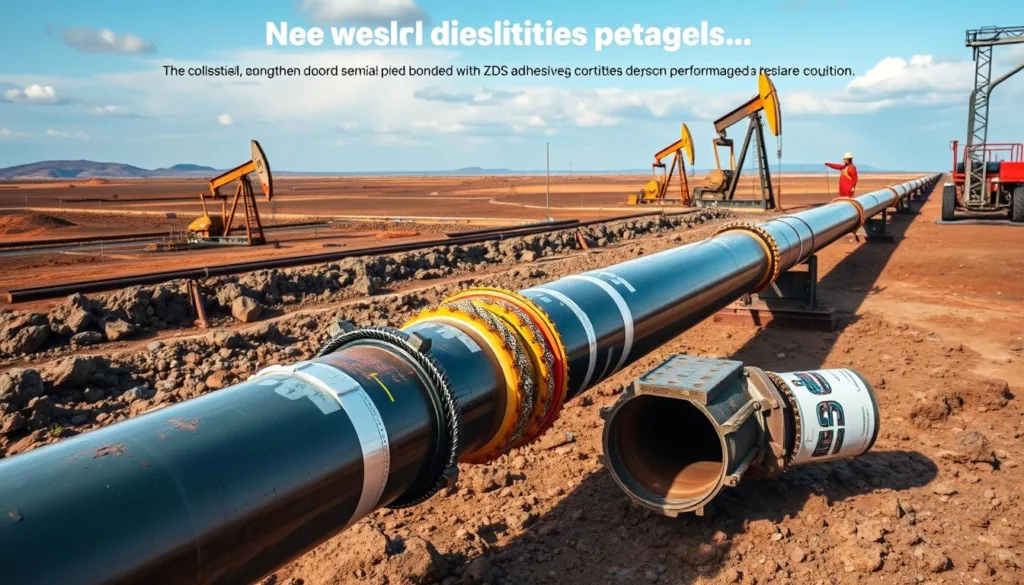
Environmental Impact and Safety Considerations
In oilfield operations, what materials we choose greatly affects the environment and worker safety. Picking chemical-resistant adhesives needs careful thought. We must see how they fit with rules and keep workers safe.
Compliance with Regulations
Following tough environmental rules is key in oilfield work. Many chemical-resistant adhesives are made to meet different federal and state laws. These adhesives cut down on VOCs. This helps lower bad emissions and supports sustainable methods. Choosing these products makes sure we follow rules and helps our environmental effect.
Worker Safety
Keeping workers safe is crucial in all fields. Using chemical-resistant adhesives designed for safety can lower the risks from harmful materials. These adhesives usually have less toxicity and are easier to handle. These steps lead to safer work environments, which are vital in the tough oilfield settings.
| Aspect | Benefits |
|---|---|
| Environmental Compliance | Minimizes VOCs and emissions |
| Worker Safety | Reduces exposure to hazardous substances |
| Sustainability | Promotes responsible material usage |
By thinking of the environment and keeping safety first, companies can improve their ways of working and stay within the law. For more info on adhesives that protect circuit boards from environmental harm, visit this informative resource.
Challenges in Selecting Adhesives for Oilfields
Finding the right adhesives for oilfield use is tricky. The challenges come from the special conditions and materials found there. Knowing these details helps make adhesive use more successful.
Compatibility with Materials
It’s important to ensure adhesives work well with different materials. Adhesives react differently to various surfaces. When they’re not compatible, it leads to bond failures, causing expensive fixes or delays. It’s best to test adhesives thoroughly to make sure they bond well with materials in oilfields.
Application Methods
The way adhesives are applied is also a big challenge. Things like temperature and how clean a surface is affect the outcome. Using the right method is crucial for strong, lasting bonds. By following best practices for applying adhesives, which can be found in resources like advanced adhesive guides, better results can be achieved.
Innovations in Chemical-Resistant Adhesive Technology
The industry is making big leaps in adhesive technology. This is key for better productivity and performance. Especially in oilfields, we’re seeing new breakthroughs in chemical-resistant adhesives. These innovations are tackling the tough conditions there. There’s a big push for adhesives that can handle harsh chemicals and extreme temperatures.
Recent Developments
Recently, we’ve seen major steps forward. These include creating adhesives that are stronger and more durable. Let’s look at what’s new:
- Enhanced bonding strength: There are now adhesives that form stronger bonds with various materials.
- Broad chemical resistance: New types can resist more chemicals without breaking down.
- Quicker curing times: These adhesives cure faster, which helps oilfield operations run more smoothly.
Future Trends
Looking ahead, the focus remains on improving adhesive technology. Ongoing research aims to meet the changing needs of the industry. Here’s what to expect:
- Sustainability: Work is underway on adhesives that are kinder to the environment.
- Smart adhesives: Future versions might include sensors for better performance tracking.
- Enhanced customization: There will be options tailored for specific oilfield challenges.
These advancements are setting new standards in the industry. They offer manufacturers advanced tools to deal with the complex issues of oilfield operations.
| Aspect | Recent Developments | Future Trends |
|---|---|---|
| Bond Strength | Enhanced bonding across diverse materials | Sustainability and eco-friendliness |
| Chemical Resistance | Expanded resistance to various chemicals | Smart technology integration |
| Curing Time | Faster curing for improved efficiency | Customization to meet specific challenges |
Case Studies: Successful Implementations
In the oilfield operations world, case studies in oilfield applications show how using chemical-resistant glues brings big benefits. These real-life stories show how well these adhesives work in different settings.
Notable Projects
Many projects worldwide have seen great results from using chemical-resistant glues:
- In an offshore drilling operation, special epoxy glues helped seal critical parts, making equipment more reliable.
- A pipeline project used polyurethane glues for bonding materials, making them last longer and resist rust.
- For quick fixes on drilling rigs, cyanoacrylate glues were used. This meant less downtime for machinery and structures.
Lessons Learned
From using these adhesives, important lessons were learned:
- Getting surfaces ready properly is key for the glue to work its best.
- Choosing the right glue based on the environment leads to better results.
- Teaching people how to use glues properly makes projects run smoother.
The knowledge gained in the field shows how vital modern glue technology is for oilfield work. Good planning and the right chemical-resistant products can make a big difference in how well operations run.
Best Practices for Using Chemical-Resistant Adhesives
To use chemical-resistant adhesives well, it’s key to know the best ways. This includes how you prepare surfaces and apply the adhesive. Doing these steps right makes the adhesive last longer and stay strong, even in tough spots like oilfields.
Surface Preparation
Getting the surface ready is a big deal for making adhesives stick better. Surfaces need to be clean and dry, without any dirt. By sticking to these steps, your adhesive will work better and last longer.
- Remove grease, oil, and dirt using solvents suitable for the surface type.
- Sanding surfaces may help increase the bonding area, enhancing adhesion.
- Consider priming surfaces that may require additional bonding strength.
Application Techniques
How you put on the adhesive matters a lot for its success. Using the right ways to apply it helps get a strong, lasting bond.
- Apply adhesives uniformly to avoid weak spots in the bond.
- Be mindful of curing times and temperature conditions to optimize bond strength.
- Use the appropriate amount of adhesive; too much or too little can compromise results.
Conclusion: The Future of Adhesive Use in Oilfield Operations
The oil and gas industry is always changing. This means the technology for adhesives in oilfields is too. We’re always working on new research. This is to make adhesives that perform well under tough conditions. We focus on creating adhesives that cure quickly, grip strongly, and can handle extreme conditions. These developments are vital as the industry tackles new challenges and demands.
Ongoing Research
Creating better adhesives is a big part of our work. We study different materials and chemicals. This helps us make adhesives that match oilfield needs perfectly. We’re looking into technologies that make adhesives more durable and versatile. Investing in new products shows we’re leading in adhesive technology.
Industry Adoption
Using advanced adhesives in oilfields helps make things run smoother and faster. As experts learn about these new adhesives, more will start using them. This change will boost how well operations work and support green practices. We make sure our innovations meet the oil and gas industry’s needs. This helps move the whole field forward.
FAQ
What are chemical-resistant adhesives?
Chemical-resistant adhesives are made to hold up against tough chemicals and extreme heat. They’re used in places like oilfields. These adhesives stick things together well, even when it’s really harsh out there.
What are the advantages of using chemical-resistant adhesives in oilfield applications?
These adhesives last longer and can handle rough conditions. They help cut down repair time and save money over time. Their special makeup keeps bonds strong, no matter how bad things get.
How do chemical-resistant adhesives enhance operational efficiency in the oil industry?
They offer reliable ways to stick things together, lowering the chance of equipment breaking. This dependability means work keeps going with less downtime for fixing things.
Can chemical-resistant adhesives protect against corrosion?
Yes, many of them also fight against corrosion. This protects oilfield gear and buildings from harmful corrosive stuff.
What types of applications are suitable for chemical-resistant adhesives in oilfields?
They’re great for sealing or sticking together tanks, pipes, and important parts to stop leaks. Also, they’re used for fixing and keeping up important oilfield equipment.
How do chemical-resistant adhesives compare with traditional adhesives?
They usually do a better job than regular adhesives. They have stronger bonds, resist heat better, and can deal with different chemicals. These qualities help avoid glue failures that could cause big problems in oilfields.
What safety and environmental considerations are there when using chemical-resistant adhesives?
Lots of these adhesives follow tough rules to keep air pollution down. This helps make oilfields safer and greener places to work.
What are some best practices for applying chemical-resistant adhesives?
Make sure the surfaces are ready, by cleaning and priming them. Follow the glue maker’s directions on how to apply it. And give it enough time to set fully for the strongest hold.
Are there any recent innovations in chemical-resistant adhesive technology?
Yes, there are new adhesives that stick better, resist more chemicals, and set faster. These improvements make sticking things together quicker and more reliable in oilfields.
How can I ensure the adhesive I choose is compatible with the materials being bonded?
Always test the adhesive with your materials and check the technical data sheets. This ensures the glue works well with what you’re sticking together, avoiding future problems.

